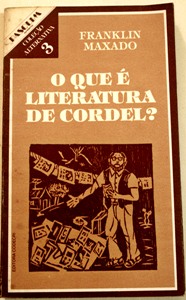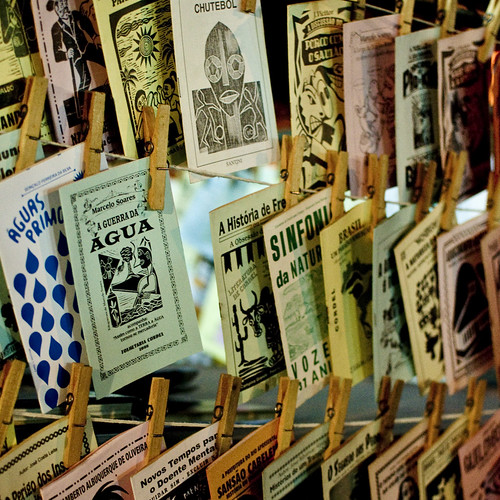Brazilian Cordel Literature : Home
- Home
- Cordel at UW-Madison
- Websites & Blogs
- Journal Articles
- Books
- Dissertations
- Youtube & Images
- U.S. Cordel Holdings
Books About Cordel Literature
-
 Retrato do Brasil em cordel
by
Mark J. Curran
Call Number: PQ9580 C85 2011ISBN: 8574805386Publication Date: 2011
Retrato do Brasil em cordel
by
Mark J. Curran
Call Number: PQ9580 C85 2011ISBN: 8574805386Publication Date: 2011 -
 La littérature de cordel au Brésil : mémoire des voix, grenier d'histoires
by
Idelette Fonseca dos Santos
Call Number: PQ9580 S36 1997ISBN: 2738458270Publication Date: 1997
La littérature de cordel au Brésil : mémoire des voix, grenier d'histoires
by
Idelette Fonseca dos Santos
Call Number: PQ9580 S36 1997ISBN: 2738458270Publication Date: 1997 -
Stories on a String: The Brazilian Literatura de Cordel by Candace Slater
Call Number: PQ9621 S5Publication Date: 1982 -
 O que é literatura de cordel?
by
Franklin Maxado
Call Number: PQ9621 M391 1980ISBN: 1982Publication Date: 1980
O que é literatura de cordel?
by
Franklin Maxado
Call Number: PQ9621 M391 1980ISBN: 1982Publication Date: 1980 -
For more recent titles in our catalog, click here.
What is Brazilian Cordel Literature?
Introduction from Curran's Cordel Connection Website:
"Literatura de Cordel from Brazil is folk-popular poetry which thrived in Northeastern Brazil for most of the twentieth century. It is written by humble, backlands poets or urban poets, most with very limited formal schooling, but with the “gift” of verse. The pioneers of cordel were from the Northeastern states of Paraíba and Pernambuco, and many were steeped in the oral tradition of the cantador or improviser of oral verse in the Northeastern poetic duel.
The poets created their stories in verse, generally in six or seven-line strophes with xaxaxa rhyme and took them to the local printing shops. The shops printed the poems in chapbooks of 8, 16, or 32 pages, illustrated the covers with decorative type until the 1920s, postcard scenes and pictures of Hollywood movie stars from the 1930s to the 1950s, and most recently and most commonly, folk woodcuts. The poet received a share of the copies printed and sold the story-poems called livro de feira or folheto de feira in the local country fair and town and city markets throughout the Northeast. He would set up a stand displaying the booklets of verse and then sing or recite the poem to the public.
The center
of cordel became Recife, Pernambuco, with poets and their
“agents”
traveling to most of the towns in the Northeast interior to sell the
verse.
But because the Northeast was plagued by drought and economic
hardship,
the poets migrated along with millions of others to the Amazon Basin,
the cities
of Rio de Janeiro and São Paulo and finally to the new capital of
Brasília.
Thus cordel became known throughout a large part of Brazil
and
represents the best of the Brazilian folk-popular tradition.
There are three major
types of cordelian poems:
1) The oral, improvised
poetic duel in written form
called the peleja.
2) “Traditional”
popular
literature, largely in a fiction mode dealing with fairy tales or love
and adventure. The largest number
of poems in cordel are in this mode.
3 Non-fiction
(in
large part) stories which report all manner of current events from the
local
to the international.
Because of the latter (n. 3), cordel became known as the “newspaper” in verse of the poor of Northeast Brazil and its poet “the voice of the people.” The current event stories now provide the main link in communication between the national media and its "recodification” in the people’s newspaper in verse."
Mark J. Curran, Curran's Cordel Connection, retreived on 05/26/2010, http://www.public.asu.edu/~atmjc/introduction.html
Related Guides
Other research guides that may also be of your interest:
Your Librarian
Topics Covered by Cordel Literature
- Introduction to new laws and governmental decrees
- News about politics
- Civic duty/voting
- Political campaigns/candidates
- History (local, national, international)
- General education
- Social issues (AIDS, the environment, divorce)
- Current events
- Morality
- Legends and folk tales (national-Lampião & international-Arthur and the Knights of the Round Table)
- Fairy tales
- Love stories
- Adventure stories
- ... and many more different topics
Guide Created by...
This Subject Guide was created by Alyson Williams and Paloma Celis Carbajal and edited by Ryan Grosvold.


